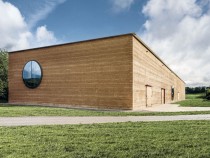
© Markus Bühler-Rasom
Situated in the Swiss municipality of Laufen, with a population of 5,000, this new centre for the Ricola company is the seventh structure Herzog & de Meuron have designed for this manufacturer of herbal lozenges and teas and probably the largest earth building in Europe. Its dimensions are impressive: 111 m long, 28.9 m wide and 10.8 m high. The facade was created in close collaboration with leading earth-construction experts Martin Rauch and his Lehm Ton Erde firm.
The original design resembled a large, timber barn with a gable roof. The present low-rise factory, with a concrete load-bearing structure and a flat roof, was developed from this initial concept to take account of functional and hygienic constraints. The delivery and removal of the herbs takes place largely underground, unless they are local products brought in by tractor. As the facade material, the architects opted for clay, which is stabilized against seismic activity by a concrete structure. Clay is a geological feature of the landscape in Laufen and has been exploited for centuries as a building material. The new factory is thus an industrialized agricultural plant that springs – like the herbs themselves – from the local soil.
Martin Rauch has developed a technique that has its experimental origins in the 1970s. Today, he and his team are regarded in Europe as the leading specialists for earth construction. Their collaboration with the architects Herzog & de Meuron dates back to the Schaulager museum in Basle, opened in 2003. The use of clay was already considered for that building, too, but the museum was ultimately implemented in another material. Manufacturing compacted-clay elements is nothing new for Martin Rauch. Since 1997, he has been experimenting in numerous projects to produce prefabricated units. The dimensions of the herb factory meant that it would not have been possible to construct it during the winter months within the time foreseen nor to maintain a constant quality level in the compacted clay. The elements were joined together on site also using clay. Externally, these appear to be well placed and part of the design. Internally, they serve the purpose of natural lighting, but do not seem to be so specifically located. (Daniel A. Walser)
The original design resembled a large, timber barn with a gable roof. The present low-rise factory, with a concrete load-bearing structure and a flat roof, was developed from this initial concept to take account of functional and hygienic constraints. The delivery and removal of the herbs takes place largely underground, unless they are local products brought in by tractor. As the facade material, the architects opted for clay, which is stabilized against seismic activity by a concrete structure. Clay is a geological feature of the landscape in Laufen and has been exploited for centuries as a building material. The new factory is thus an industrialized agricultural plant that springs – like the herbs themselves – from the local soil.
Martin Rauch has developed a technique that has its experimental origins in the 1970s. Today, he and his team are regarded in Europe as the leading specialists for earth construction. Their collaboration with the architects Herzog & de Meuron dates back to the Schaulager museum in Basle, opened in 2003. The use of clay was already considered for that building, too, but the museum was ultimately implemented in another material. Manufacturing compacted-clay elements is nothing new for Martin Rauch. Since 1997, he has been experimenting in numerous projects to produce prefabricated units. The dimensions of the herb factory meant that it would not have been possible to construct it during the winter months within the time foreseen nor to maintain a constant quality level in the compacted clay. The elements were joined together on site also using clay. Externally, these appear to be well placed and part of the design. Internally, they serve the purpose of natural lighting, but do not seem to be so specifically located. (Daniel A. Walser)





